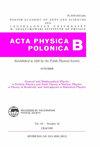The Standard Model of Particle Physics as a Conspiracy Theory and the Possible Role of the Higgs Boson in the Evolution of the Early Universe
IF 1.4
4区 物理与天体物理
Q3 PHYSICS, MULTIDISCIPLINARY
引用次数: 5
Abstract
I am considering Veltman’s “The Infrared–Ultraviolet Connection” addressing the issue of quadratic divergences and the related huge radiative correction predicted by the electroweak Standard Model (SM) in the relationship between the bare and the renormalized theory, commonly called “the hierarchy problem” which usually is claimed that this has to be cured. After the discovery of the Higgs particle at CERN, which essentially completed the SM, an amazing interrelation of the leading interaction strengths of the gauge bosons, the top quark, and the Higgs boson showed up amounting that the SM allows for a perturbative extrapolation of the running couplings up to the Planck scale. The central question concerns the stability of the electroweak vacuum, which requires that the running Higgs self-coupling stays positive. Although several evaluations seem to favor the meta-stability within the experimental and theoretical parameter-uncertainties, one should not exclude the possibility that other experiments and improved matching conditions will be able to establish the absolute stability of the SM vacuum in the future. I will discuss the stable vacuum scenario and its impact on early cosmology, revealing the Higgs boson as the inflaton. It turns out that the Standard Model’s presumed “hierarchy problem” and similarly the “cosmological constant problem” resolve themselves when we understand the SM as a low-energy effective tail that is emergent from a cutoff-medium at the Planck scale. “The Infrared–Ultraviolet Connection” conveyed by the Higgs boson mass renormalization appears in a new light when the energy dependence of the SM couplings is taken into account.作为阴谋论的粒子物理学标准模型和希格斯玻色子在早期宇宙演化中的可能作用
我正在考虑Veltman的《红外-紫外连接》,该书解决了电弱标准模型(SM)在裸理论和重整化理论之间的关系中预测的二次发散和相关的巨大辐射校正问题,通常称为“层次问题”,通常声称这必须解决。在欧洲核子研究中心发现希格斯粒子后,基本上完成了SM,规范玻色子、顶夸克和希格斯玻色子的主要相互作用强度之间出现了惊人的相互关系,表明SM允许对普朗克尺度下的运行耦合进行微扰外推。中心问题涉及电弱真空的稳定性,这需要运行的希格斯自耦保持正态。尽管一些评估似乎有利于实验和理论参数不确定性范围内的元稳定性,但不应排除其他实验和改进的匹配条件将能够在未来建立SM真空的绝对稳定性的可能性。我将讨论稳定的真空场景及其对早期宇宙学的影响,揭示希格斯玻色子作为充气子。事实证明,当我们将SM理解为从普朗克尺度的截止介质中产生的低能量有效尾巴时,标准模型假定的“层次问题”和类似的“宇宙学常数问题”就会自行解决。当考虑到SM耦合的能量依赖性时,希格斯玻色子质量重整化所传达的“红外-紫外连接”出现在一种新的光中。
本文章由计算机程序翻译,如有差异,请以英文原文为准。
求助全文
约1分钟内获得全文
求助全文
来源期刊

Acta Physica Polonica B
物理-物理:综合
CiteScore
1.70
自引率
20.00%
发文量
30
审稿时长
3-8 weeks
期刊介绍:
Acta Physica Polonica B covers the following areas of physics:
-General and Mathematical Physics-
Particle Physics and Field Theory-
Nuclear Physics-
Theory of Relativity and Astrophysics-
Statistical Physics
 求助内容:
求助内容: 应助结果提醒方式:
应助结果提醒方式:


